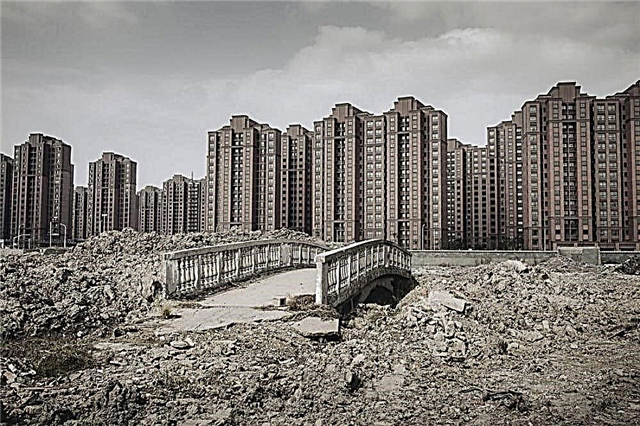Going on a trip to China, you can notice a certain phenomenon - the presence of large, well-thought-out megacities, which are either completely uninhabited, or the number of inhabitants in them is so small that one gets the impression of an abandoned civilization. Many research centers around the world are wondering who the ghost towns in China are for, why they are being built.
Where did the phenomenon of dead cities in China come from?
About 15 years ago, the Chinese government allowed its citizens to buy houses and apartments. Since that time, the real estate market has grown significantly, which developers immediately took advantage of. Practically in all Chinese cities, they began to actively build new residential areas of high-rise buildings, amusement parks, and shopping malls.

For your information!For the construction of such districts and cities, more concrete was taken in three years than throughout the United States in the 20th century.
Thus, construction has had a significant impact on the growth of the country's GDP. The government provided generous lending and developed a plan to relocate poor, rural residents to metropolitan areas with well-developed infrastructure and plenty of jobs. People were lured into uninhabited cities in China by buying out their land and paying off the maintenance fees for apartments in skyscrapers.

Despite the fact that empty cities in China are more like ghosts, they are just waiting in the wings. Some citizens, making a purchase of housing in such areas, are confident that this is a promising investment for the future.
How many empty cities in China are known
According to some estimates, China now has about 64 million empty houses with all amenities and developed infrastructure using the most modern technologies. The state builds on its free territories up to20 new empty cities a year, where half of the inhabitants of the post-Soviet space could be settled.
Note! Baidu, a major Chinese Internet company, conducted its research and identified the 50 largest regions across the country where new habitable developments remain unoccupied.
The reason why in China 50 uninhabited cities, lies in the fact that many residents, contrary to the expectations of the government, have not moved to live in such areas, or the developers have gone bankrupt, and now the houses are empty. Whole residential areas, shopping malls, squares, parks and entertainment areas are patiently waiting for new settlers.
According to images on Google Earth maps, such cities are home to office skyscrapers, administration buildings, empty houses, connected by a network of highways. In one of these cities in southern China, the world's second largest shopping and entertainment complex after DubaiMall was opened. The shopping mall New South China Mall in the city of Dongguan is designed for more than 2 thousand stores, but since its opening it has been almost completely empty.
Why create dead cities
You May Also Like
One of the versions why there are empty cities in China is that the inhabitants of the country did not want to populate new buildings with all the amenities, since they were built on remote islands, and the natural conditions are unsuitable for normal life. Therefore, entire megalopolises, which remained far from active trade routes and large enterprises, remain uninhabited.
Note! The price of real estate has grown significantly in recent years, the average Chinese cannot afford to buy expensive housing in remote areas, so he prefers to squeeze in densely populated cities, where it is easier to find cheap housing.

Another version of the appearance of dead cities is that they are a reserve fund for the population, for example, in case of war. It makes no sense to destroy such buildings, there are goals that are much more important. If a strike (and most likely a nuclear strike) hits the existing populated cities, it will be economically and practically difficult to rebuild and build during the war. It is much more profitable to set up places in advance where it will be possible to resettle your citizens and transport equipment from factories and factories to recuperate.
The most famous empty cities
Built in the Celestial Empire 50 empty cities and districts, and their number is growing every year. Nobody can say for sure how long the construction of reserve houses for the resettlement program will continue. Among the large number of ghost towns, several of the most famous stand out:
- Ordos;
- Kangbashi;
- Tyanducheng;
- New Nanhuen;
- Thames Town, etc.
Ordos is one of the largest ghost towns in China. Its construction has begun 20 years ago during the great Mongolian coal rush. In the Mongolian steppes, active coal mining began, farmers sold their plots to coal companies, trains of trucks with coal were pulled to developed areas in southern China. Ordos began to grow at the expense of coal money.
The Ordos authorities decided it was their time and developed a plan to build a large city with a million inhabitants. As a result, Ordos was built with high-rise buildings, museums, theaters, a large stadium and even a race track. But it remained empty, people did not go to live there. The reason was that many mines in the vicinity of Ordos turned out to be unprofitable and began to gradually close, there was no work for the residents, so the artificially created city remained empty.
Note!Ordos did not become the center of the coal industry, but found application in the tourism business.
Considering Ordos as a tourist destination, they note that if not one of the best, then definitely not bad and is the most famous among many similar ones in China. Despite the abandonment, the cleanliness of the city is striking. Pedestrians are rarely seen here, but there are public servants who keep the sidewalks clean.

There is no data on how many residents are in Ordos. Local authorities shy away from answering the question of how many citizens live in the city. At last count, the population has tripled from 30 to 100 thousand.
For tourists, this area is attractive because Ordos has a Mongolian Disneyland and a romantic park "Ordos Wedding" with many themed statues. There is also the Marital Longevity Square and the Traditional Chinese Love Recreation Park.
You May Also Like
The empty building of the party institute, unpopulated neighborhoods, roads without cars and buses without passengers are very reminiscent of the plot of a film about life after the apocalypse. But, despite the absence of the population, there is a local travel agency in Ordos, although the employees say that there is no work, but they receive their wages on time and are not delayed.
By building Ordos, China hoped to make a big profit from natural coal deposits, but things turned out differently. The city looks well-groomed, clean, flowers are fragrant, perfect lawns, but the only thing missing is the empty metropolis.
Another Chinese ghost town is Kangbashi, which is part of the Ordos urban district. After receiving impressive money from the sale of coal, local officials decided to build an entirely new city to attract residents and investment. The total area of Kangbashi is 350 m², but, as in the neighboring town, the population is only 30 thousand inhabitants.
When building a metropolis, they did not limit themselves to residential buildings, they immediately rebuilt the entire infrastructure:
- hospitals;
- the shops;
- municipal buildings;
- offices;
- parks.
Note!Kangbashi parks are decorated in traditional Mongolian style with statues of horses, khan, camels, etc.

During the day, the streets look deserted, deserted. With the onset of evening, cars appear on the roads, albeit a little, but there are, cafes open, in the windows of houses, albeit occasionally, lights are turned on, and in the morning the city is empty again, and only the workers of public utilities remain, keeping the city clean.
Despite the lack of prospects for living in the city, the construction of residential areas is still ongoing, new multi-storey buildings are being prepared for future settlement.
Another famous ghost town of Tanducheng is located on the east coast of China. It is also called "Little Paris". The city was built in 2007 for 10 thousand residents with the aim of developing the tourism sector. To attract tourists and wealthy Chinese, copies of famous architectural buildings were built - the Eiffel Tower, Notre Dame Cathedral, Champs Elysees, etc.
Important! The authorities' expectations of the relocation of Chinese citizens to the new Paris did not come true, and the population is no more than 2 thousand. Nevertheless, Tanducheng attracts tourists, especially newlyweds, for whom the city has a large number of ideal places to take wedding photographs.

Not far from China's largest metropolis - Shanghai - New Nanhuen was built. According to the plan of the government of the state, it was supposed to turn into a large commercial port and tourist center, that is, into a new Hong Kong. But so far this plan does not work, since quite recently the city was practically deserted.
To attract residents to a city with a population 10 thousand citizens a large number of universities in various directions were created. Today, about 100 thousand students live and receive education in New Nanhuen. Time will tell whether the city will turn into a thriving metropolis or remain a large student city.

V2006 year a typical British city, Thames Town, was built in Shanghai. It was assumed that he would gain popularity among wealthy Chinese who dream of living "like in Europe." But even considering the large amount of funds invested in the creation of the London Quarter, it did not become popular.
For your information! It was not possible to convey the theme of the English town in full, the traditional London Black Cab Taxi TX4 of Chinese production and rental housing in this area turned out to be overstated, and the project did not live up to the government's hopes.
The construction of Thames Town involved relocation to it around 10 thousand people... Constructed small houses in a restrained English style, created cobbled streets with signs of Oxford or Queen, red telephone booths, a Gothic cathedral copying the church in Bristol, the impromptu River Thames never arrived.

Forced urbanization of the state is an important concept in China's socio-economic development. Every year about 10 million Chinese migrate from villages to cities, and they all need to live somewhere. So if not today, then in the near future, most ghost cities will show signs of active life.











